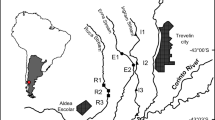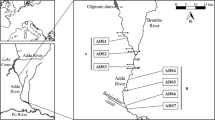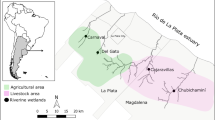Abstract
Water abstraction for irrigation has an important effect on stream organisms in general and aquatic macroinvertebrates in particular. The alteration of flow modifies the habitat conditions and creates important ecological constraints for many of these animals, so shaping the communities and affecting their diversity. With the aim to assess the impact of flow and habitat changes due to water abstraction for agriculture on the macroinvertebrate community of a Mediterranean stream, we characterized physicochemically three sampling sites representing three habitat types and collected the macroinvertebrate assemblage of each one. The three sites were a spring, an irrigation ditch 90 m downstream from the spring that diverge all the water from the natural channel and return it downstream, and a site after an area of agriculture 500 m downstream of the spring. Our hypothesis was that the highest diversity would be found in the irrigation ditch, where conditions were more constant along the year and that could act as a refuge for some organisms, followed by the spring and, afterwards, the downstream site, which would have a very poor community. Nonetheless, although our results showed that the irrigation ditch had the highest values of diversity, the spring and the downstream site did not differ significantly. When analysing the effect of the measured physicochemical parameters on macroinvertebrate communities, the most important was discharge. Thus, our study underlines the effect that water diversion may have on the macroinvertebrate communities even at a small watershed scale.




Similar content being viewed by others
References
Allan JD, Castillo MM (2007) Stream ecology: structure and function of running waters. Springer, Dordrecht
Al-Shami SA, Rawi CSM, Ahmad AH, Hamid SA, Nor SAM (2011) Influence of agricultural, industrial, and anthropogenic stresses on the distribution and diversity of macroinvertebrates in Juru River Basin, Penang, Malaysia. Ecotoxicol Environ Saf 74:1195–1202
Barquín J, Death RG (2004) Patterns of invertebrate diversity in streams and freshwater springs in Northern Spain. Arch Hydrobiol 161:329–349
Calapez AR, Branco P, Santos JM, Ferreira T, Hein T, Brito AG, Feio MJ (2017) Macroinvertebrate short-term responses to flow variation and oxygen depletion: a mesocosm approach. Sci Total Environ 599–600:1202–1212
Calapez AR, Serra SRQ, Santos JM, Branco P, Ferreira T, Hein T, Brito AG, Feio MJ (2018) The effect of hypoxia and flow decrease in macroinvertebrate functional responses: a trait-based approach to multiple-stressors in mesocosms. Sci Total Environ 637–638:647–656
Chessman BC, Jones HA, Searle NK, Growns IO, Pearson MR (2010) Assessing effects of flow alteration on macroinvertebrate assemblages in Australian dryland rivers. Freshw Biol 55:1780–1800
Clarke KR (1993) Non-parametric multivariate analyses of changes in community structure. Aust J Ecol 18:117–143
Clarke A, Mac Nally R, Bond N, Lake PS (2010) Flow permanence affects aquatic macroinvertebrate diversity and community structure in three headwater streams in a forested catchment. Can J Fish Aquat Sci 67:1649–1657
Davies PM, Naiman RJ, Warfe DM, Pettit NE, Arthington AH, Bunn SE (2014) Flow–ecology relationships: closing the loop on effective environmental flows. Mar Freshw Res 65:133–141
Döll P, Schmied HM (2012) How is the impact of climate change on river flow regimes related to the impact on mean annual runoff? a global-scale analysis. Environ Res Lett 7:014037
Dolph CL, Eggert SL, Magner J, Ferrington LCJ, Vondracek B (2015) Reach-scale stream restoration in agricultural streams of southern Minnesota alters structural and functional responses of macroinvertebrates. Freshw Sci 34:535–546
Doretto A, Piano E, Bona F, Fenoglio S (2018a) How to assess the impact of fine sediments on the macroinvertebrate communities of alpine streams? a selection of the best metrics. Ecol Indic 84:60–69
Doretto A, Piano E, Falasco E, Fenoglio S, Bruno MC, Bona F (2018b) Investigating the role of refuges and drift on the resilience of macroinvertebrate communities to drying conditions: an experiment in artificial streams. River Res Appl 62:245–249
Egler M, Buss DF, Moreira JC, Baptista DF (2012) Influence of agricultural land-use and pesticides on benthic macroinvertebrate assemblages in an agricultural river basin in southeast Brazil. Braz J Biol 72:437–443
Fournier M-L, Echeverría-Sáenz S, Mena F, Arias-Andrés M, de la Cruz E, Ruepert C (2018) Risk assessment of agriculture impact on the Frío River watershed and Caño Negro Ramsar wetland, Costa Rica. Environ Sci Pollut Res 25:13347–13359
Genito D, Gburek WJ, Sharpley AN (2002) Response of stream macroinvertebrates to agricultural land cover in a small watershed. J Freshw Ecol 17:109–119
Gerth WJ, Li J, Giannico GR (2017) Agricultural land use and macroinvertebrate assemblages in lowland temporary streams of the Willamette Valley, Oregon, USA. Agric Ecosyst Environ 236:154–165
Hepp LU, Milesi SV, Biasi C, Restello RM (2010) Effects of agricultural and urban impacts on macroinvertebrates assemblages in streams (Rio Grande do Sul, Brazil). Zoologia 27:106–113
Hershkovitz Y, Gasith A (2013) Resistance, resilience, and community dynamics in mediterranean-climate streams. Hydrobiologia 719:59–75
Hunt L, Marrochi N, Bonetto C, Liess M, Buss DF, Vieira da Silva C, Ciu M-C, Resh VH (2017) Do Riparian buffers protect stream invertebrate communities in South American Atlantic forest agricultural areas? Environ Manag 60:1155–1170
James AB, Dewson ZS, Death RG (2008) Do stream macroinvertebrates use instream refugia in response to severe short-term flow reduction in New Zealand streams? Freshw Biol 53:1316–1334
Käiro K, Haldna M, Timm H, Virro T (2017) The effect of channelization on the biological quality of lowland streams using macroinvertebrates as proxies. Hydrobiologia 794:167–177
Karaouzas I, Gritzalis KC, Skoulikidis N (2007) Land use effects on macroinvertebrate assemblages and stream quality along an agricultural river basin. Fresenius Environ Bull 16:645–653
Kavanagh JA, Harrison SSC (2014) The contribution of a drainage network to the spatial and temporal patterns of macroinvertebrate diversity across an agricultural headwater catchment. Biol Environ Proc R Irish Acad 114B:181–197
Krebs CJ (1999) Ecological methodology. Harper and Row, New York
Lake PS (2000) Disturbance, patchiness, and diversity in streams. J N Am Benthol Soc 19:573–592
Lange K, Townsend CR, Matthaei CD (2014) Can biological traits of stream invertebrates help disentangle the effects of multiple stressors in an agricultural catchment? Freshw Biol 59:2431–2446
Li F, Cai Q, Jiang W, Qu X, Jia X (2012) Flow-related disturbances in forested and agricultural rivers: influences on benthic macroinvertebrates. Int Rev Hydrobiol 97:215–232
Meybeck M (2003) Global analysis of river systems: from Earth system controls to Anthropocene syndromes. Philos Trans R Soc Lond Ser B Biol Sci 358:1935–1955
Naden PS, Murphy JF, Old GH, Newman J, Scarlett P, Harman M, Duerdoth CP, Hawczak A, Pretty JL, Arnold A, Laizé C, Hornby DD, Collins AL, Sear DA, Jones JI (2016) Understanding the controls on deposited fine sediment in the streams of agricultural catchments. Sci Total Environ 547:366–381
Nakano D, Tsuno M (2016) Macroinvertebrate assemblages in an artificial habitat—a settling basin of a hydroelectric power plant: comparison with a natural riffle habitat. Limnology 17:201–206
Oksanen J, Guillaume Blanchet F, Friendly M, Kindt R, Legendre P, McGlinn D, Minchin PR, O’Hara RB, Simpson GL, Solymos P, Stevens MHH, Szoecs E, Wagner H (2018) vegan: Community ecology package. R package version 2.5-2. https://CRAN.R-project.org/package=vegan. Accessed 25 Sept 2018
Piano E, Doretto A, Falasco E, Fenoglio S, Gruppuso L, Nizzoli D, Viaroli P, Bona F (2019) If Alpine streams run dry: the drought memory of benthic communities. Aquat Sci 81:32. https://doi.org/10.1007/s00027-019-0629-0
Poff NL, Allan JD, Bain MB, Karr JR, Prestegaard KL, Richter BD, Sparks RE, Stromberg JC (1997) The natural flow regime. Bioscience 47:769–784
R Core Team (2018) R: a language and environment for statistical computing. R Foundation for Statistical Computing, Vienna, Austria. https://www.R-project.org/. Accessed 25 Sept 2018
Richards C, Host GE, Arthur JW (1993) Identification of predominant environmental factors structuring stream macroinvertebrate communities within a large agricultural catchment. Freshw Biol 29:285–294
Rolls RJ, Leigh C, Sheldon F (2012) Mechanistic effects of low-flow hydrology on riverine ecosystems: ecological principles and consequences of alteration. Freshw Sci 31:1163–1186
Rolls RJ, Heino J, Ryder DS, Chessman BC, Growns IO, Thompson RM, Gido KB (2018) Scaling biodiversity responses to hydrological regimes. Biol Rev 93:971–995
Salmaso F, Crosa G, Espa P, Gentili G, Quadroni S, Zaccara S (2018) Benthic macroinvertebrates response to water management in a lowland river: effects of hydro-power vs irrigation off-stream diversions. Environ Monit Assess 190:33
Santos AN, Stevenson RD (2011) Comparison of macroinvertebrate diversity and community structure among perennial and non-perennial headwater streams. Northeast Nat 18:7–26
Sheldon F, Thoms MC (2006) Relationships between flow variability and macroinvertebrate assemblage composition: data from four Australian dryland rivers. River Res Appl 22:219–238
Smith H, Wood PJ (2002) Flow permanence and macroinvertebrate community variability in limestone spring systems. Hydrobiologia 487:45–58
Solis M, Bonetto C, Marrochi N, Paracampo A, Mugni H (2018) Aquatic macroinvertebrate assemblages are affected by insecticide applications on the Argentine Pampas. Ecotoxicol Environ Saf 148:11–16
Sponseller RA, Benfield EF, Valett HM (2001) Relationships between land use, spatial scale and stream macroinvertebrate communities. Freshw Biol 46:1409–1424
Storey R (2016) Macroinvertebrate community responses to duration, intensity and timing of annual dry events in intermittent forested and pasture streams. Aquat Sci 78:395–414
Stubbington R (2012) The hyporheic zone as an invertebrate refuge: a review of variability in space, time, taxa and behaviour. Mar Freshw Res 63:293–311
Thorp JH (2015) Functional relationships of freshwater invertebrates. In: Thorp JH, Rogers DC (eds) Ecology and general biology. Thorp and Covich’s freshwater invertebrates, vol 1, 4th edn. Elsevier, London, pp 65–82
Vander Vorste R, Malard F, Datry T (2016) Is drift the primary process promoting the resilience of river invertebrate communities? a manipulative field experiment in an intermittent alluvial river. Freshw Biol 61:1276–1292
Vörösmarty C, Lettenmaier D, Lévêque C, Meybeck M, Pahl-Wostl C, Alcamo J et al (2004) Humans transforming the global water system. EOS 85:509–520
Vörösmarty CJ, McIntyre PB, Gessner MO, Dudgeon D, Prusevich A, Green P et al (2010) Global threats to human water security and river biodiversity. Nature 467:555–561
White JC, House A, Punchard N, Hannah DM, Wilding NA, Wood PJ (2018) Macroinvertebrate community responses to hydrological controls and groundwater abstraction effects across intermittent and perennial headwater streams. Sci Total Environ 610:1514–1526
Acknowledgements
Authors are very grateful to Dr. E. Larios López for the elaboration of Fig. 1, and to two anonymous reviewers who improved the original version of the manuscript.
Author information
Authors and Affiliations
Corresponding author
Additional information
Handling Editor: Télesphore Sime-Ngando.
Publisher's Note
Springer Nature remains neutral with regard to jurisdictional claims in published maps and institutional affiliations.
Electronic supplementary material
Below is the link to the electronic supplementary material.
Rights and permissions
About this article
Cite this article
López-Rodríguez, M.J., Márquez Muñoz, C., Ripoll-Martín, E. et al. Effect of shifts in habitats and flow regime associated to water diversion for agriculture on the macroinvertebrate community of a small watershed. Aquat Ecol 53, 483–495 (2019). https://doi.org/10.1007/s10452-019-09703-6
Received:
Accepted:
Published:
Issue Date:
DOI: https://doi.org/10.1007/s10452-019-09703-6




